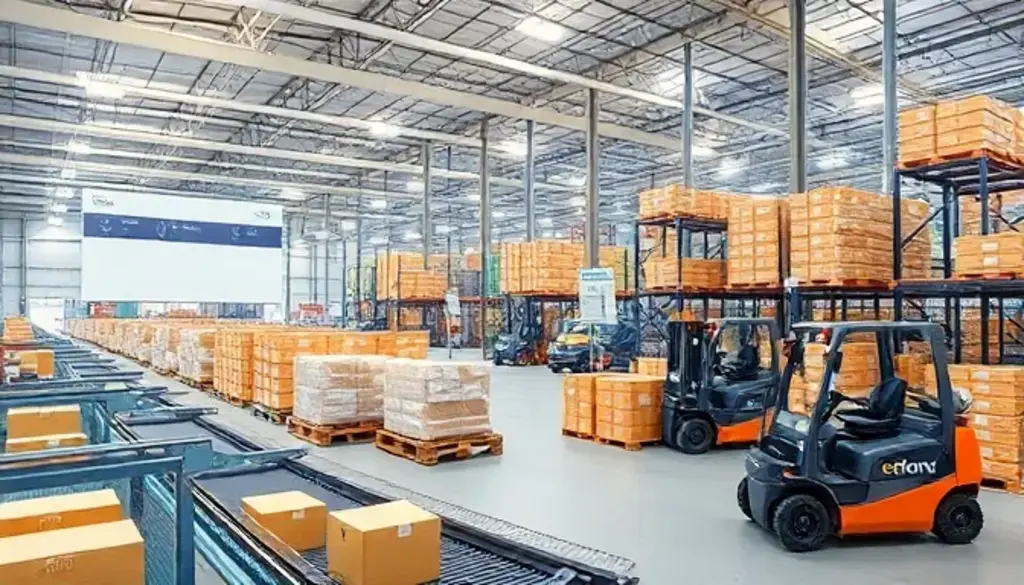
In the quest for operational excellence in warehousing, Key Performance Indicators (KPIs) are indispensable. They track progress, pinpoint inefficiencies, and drive strategy. But which warehouse KPIs are most crucial? This article hones in on the top warehouse kpi you need to measure to keep your operations sharp, inventories balanced, and customers satisfied.
Key Takeaways
- Warehouse KPIs are essential for monitoring and improving the efficiency and effectiveness of a warehouse’s operations, including optimizing inventory management and enhancing customer satisfaction.
- Specific KPIs such as inventory turnover, carrying costs, and accuracy are vital for maintaining an optimized inventory level, and KPIs related to order fulfillment like lead time and on-time delivery directly impact customer satisfaction.
- Implementing warehouse KPIs involves choosing relevant metrics, utilizing warehouse management systems for efficient tracking, and continuously monitoring and adjusting KPIs to align with changing business goals and market conditions.
The Importance of Warehouse KPIs
Warehouse KPIs, or warehouse key performance indicators, are the heartbeat of your warehouse, reflecting its health and vitality. They are crucial for assessing the effectiveness of warehouse processes, making data-driven decisions, and evaluating performance trends to manage risks and uncover potential problems. Think of them as your warehouse’s control panel, giving you real-time information about every aspect of your operations. Incorporating warehouse management kpi helps optimize inventory allocation, identify efficiencies, and streamline operations, driving profitability while reducing costs.
And it’s not just about boosting efficiency and cutting costs. Optimized inventory management and operational efficiency directly enhance customer satisfaction by ensuring timely order fulfillment. But how exactly do KPIs boost efficiency, optimize inventory management, and enhance customer satisfaction? Let’s explore.
Boost Efficiency
Efficiency is the lifeblood of any warehouse. And key performance indicators (KPIs) are the perfect tool for boosting it. They help identify bottlenecks in warehouse operations, which are like speed bumps slowing down the flow of your operations. By pinpointing these areas of weakness, you can target optimizations to address inefficiencies and improve operational flows, significantly enhancing overall efficiency.
But boosting efficiency isn’t just about smoothing out the kinks in your operations. It’s also about making the most of your warehouse capacity. By optimizing warehouse capacity, you ensure efficient space utilization, which translates to reduced costs and prepares you for future expansion needs. So, by tracking warehouse KPIs, you’re not just enhancing efficiency but also paving the way for growth and profitability.
Optimize Inventory Management
Inventory is like the fuel that drives your warehouse engine. But just as having too much or too little fuel can damage an engine, so can having too much or too little inventory disrupt your warehouse operations. That’s where KPIs come in. They play a crucial role in reducing carrying costs and preventing stockouts by guiding the balance of average inventory levels.
But it’s not just about balancing inventory levels. Inventory accuracy is crucial for optimizing inventory levels and contributing to more efficient warehouse operations. It prevents stockouts, reduces carrying costs and ensures that your inventory records reflect the actual state of your warehouse. So, by optimizing inventory management through KPIs, you’re ensuring that your warehouse engine runs smoothly, efficiently, and cost-effectively.
Enhance Customer Satisfaction
Your warehouse may be running smoothly, your inventory may be perfectly balanced, but if your customers aren’t happy, it’s all in vain. That’s where KPIs related to order fulfillment and timely delivery come into play. By monitoring these KPIs, you can significantly enhance customer satisfaction.
Why? Because delivering better customer experiences through accurate order fulfillment and timely deliveries is a direct outcome of monitoring warehouse KPIs related to these aspects. And when you improve customer service by employing KPIs that track order fill rate and on-time delivery, you’re not just addressing issues promptly. You’re also avoiding unexpected back orders and dissatisfied customers, while also reducing higher costs, highlighting the critical role of inventory accuracy in customer satisfaction.
So, KPIs aren’t just about boosting your warehouse performance. They’re also about boosting your reputation in the eyes of your customers.

Inventory Management KPIs
Now that we’ve explored the importance of warehouse KPIs, let’s delve into some specific KPIs related to inventory management. These KPIs, which include inventory turnover, carrying cost of inventory, and inventory accuracy, are your tools for efficient warehouse stock management. By measuring these KPIs, you can evaluate the efficiency and effectiveness of your warehouse stock management, which is crucial for maintaining an optimized warehouse operation.
But how exactly do these KPIs work? Let’s dig deeper!
Carrying Cost of Inventory
The carrying cost of inventory includes:
- Storage costs
- Insurance costs
- Potential depreciation
- Opportunity cost
- Cost associated with deterioration and obsolescence
These costs represent a significant portion of current assets on your company’s balance sheet.
But here’s the good news. You can reduce your inventory carrying costs. How? By minimizing inventory on hand, optimizing warehouse space, and increasing inventory turnover. This way, you’re not just lightening the weight your business carries. You’re also steering your business towards higher profitability.
Inventory Turnover Rate
Think of inventory turnover rate as the pulse of your warehouse. It measures how often your company sells and replaces its stock of goods within a certain period, serving as a measure of sales efficiency. A high inventory turnover indicates efficient inventory management and strong sales, while low turnover can suggest excess stock or poor sales.
But it’s not just about measuring sales efficiency. Inventory turnover rate is crucial for assessing the liquidity of your company’s inventory and its ability to convert inventory into cash. A high inventory turnover rate may reflect strong market demand and efficient operations, whereas a low turnover rate could signal overstocking or reduced demand for your products. By analyzing the inventory to sales ratio and the overall sales ratio, you can gain further insight into your company’s performance.
So, by monitoring your inventory turnover rate, you’re keeping your finger on the pulse of your warehouse, ready to respond to any changes.
Inventory Accuracy
Imagine trying to navigate a city without a map. That’s what managing a warehouse without inventory accuracy feels like. Inventory accuracy measures the conformity of physically present inventory with the quantities recorded in inventory systems. It’s like your warehouse’s map, guiding you to the exact location of your inventory.
By accurately tracking inventory, you can improve warehouse efficiency by allowing better forecasting, reducing losses, and avoiding potential discrepancies. And it’s not just about avoiding losses. Accurate inventory tracking also contributes to customer satisfaction by ensuring timely order fulfillment and avoiding unexpected stockouts.
So, by maintaining accurate inventory records, you’re not just navigating your warehouse with ease. You’re also steering your warehouse towards greater efficiency and customer satisfaction.
Order Fulfillment KPIs
Let’s move on to another set of crucial KPIs – order fulfillment KPIs. These KPIs, which include order lead time, perfect order rate, and on-time delivery, are your tools for ensuring efficient inventory management and customer satisfaction. By monitoring these KPIs, you can improve your order fulfillment process, delivering orders that are complete, accurate, and without errors.
But how exactly do these KPIs work? Let’s find out.
Order Lead Time
Order lead time is like the beat of a drum, setting the rhythm of your order fulfillment process. It’s the total duration from the moment an order is placed until it is delivered to the customer. The faster the beat, the shorter the lead time, and the happier your customers.
Shorter order lead times can significantly enhance customer satisfaction as customers generally prefer receiving their orders promptly. And it’s not just about making your customers happy. Optimizing order lead time is crucial for warehouse performance as it can influence inventory turnover and operational efficiency. So, by reducing order lead time, you’re not just setting a brisk beat for your order fulfillment process. You’re also setting the stage for efficient warehouse operations and satisfied customers.
Perfect Order Rate
The perfect order rate is like a bullseye, marking the target of your order fulfillment process. It measures the precision of picking the correct SKU to ensure error-free order fulfillment. The closer you get to the bullseye, the higher the perfect order rate, and the smoother your order fulfillment process.
Improving the perfect order rate isn’t just about reducing errors. It’s also about streamlining warehouse operations. By adhering to best practices, you can improve your perfect order rate, which leads to satisfied customers and optimal warehouse performance. So, by aiming for a high perfect order rate, you’re not just hitting the bullseye of your order fulfillment process. You’re also hitting the target of efficient warehouse operations and customer satisfaction.
On-time Delivery
On-time delivery is like the punctuality of your warehouse. It’s crucial for achieving customer satisfaction and maintaining a strong brand reputation. Just as punctuality is a sign of respect for someone else’s time, on-time delivery is a signal of respect for your customer’s time.
But how can you improve on-time delivery rates? By using a warehouse management system. It can help reduce picking errors, manage inventory in real time, and fulfill orders more quickly, contributing to better on-time delivery rates.
So, by ensuring on-time delivery, you’re not just respecting your customers’ time. You’re also building a strong reputation for your brand and boosting customer satisfaction.

Warehousing Operations KPIs
Let’s shift gears and delve into warehousing operations KPIs. These KPIs, which include receiving efficiency, put-away accuracy, and picking productivity, are your tools for optimizing warehouse processes. By monitoring these KPIs, you can streamline operations, optimize space utilization, and minimize errors.
Let’s explore how these KPIs work.
Receiving Efficiency
Receiving efficiency is like the welcome mat at the door of your warehouse. It quantifies your warehouse’s ability to process incoming goods effectively. The more efficient your receiving process, the smoother the flow of goods into your warehouse.
But it’s not just about welcoming goods into your warehouse. Optimizing the inward goods process can free up time and resources for other areas within your company and decrease warehouse costs. By enhancing receiving efficiency you’re creating a smoother, more efficient, and more cost-effective warehouse operation.
Put-away Accuracy
Put-away accuracy is like the GPS of your warehouse. It refers to the precision of storing the delivered items in their designated areas within the warehouse. The more accurate your put-away process, the less time and resources are wasted in locating items.
But it’s not just about saving time and resources. The put-away cycle time, which measures the time from when goods are received to when they are stored, is also critical for identifying efficiency bottlenecks and contributes to a faster inventory turnover, thereby influencing put-away accuracy. So, by improving put-away accuracy, you’re not just optimizing your warehouse’s GPS. You’re also optimizing its efficiency and profitability.
Picking Productivity
Picking productivity is like the speed of your warehouse workers. It measures the efficiency of order selection and preparation for delivery, which directly affects order fulfillment and customer satisfaction. The faster your workers can pick and prepare orders, the higher your picking productivity.
But it’s not just about speed. Improving picking accuracy is pivotal, not only for reducing errors but also for streamlining warehouse operations. So, by boosting picking productivity, you’re not just increasing the speed of your workers. You’re also increasing the speed and efficiency of your entire warehouse operation.
Warehouse Safety and Employee KPIs
Now, let’s shift our focus to warehouse safety and employee KPIs. These KPIs, which include accidents per year, employee turnover rate, and employee net promoter score, are your tools for creating a safe and productive work environment. By monitoring these KPIs, you can prevent accidents, improve employee satisfaction, and boost productivity.
Accidents per Year
Accidents per year is like the safety gauge of your warehouse. It signals the scale of safety issues within a year and aids in preventing future accidents. The lower the number of accidents, the safer your warehouse.
But it’s not just about preventing accidents. Aiming to minimize accidents per year, with the ideal goal of zero, ensures the maintenance of a safe warehouse environment. So, by reducing accidents per year, you’re not just reducing safety risks. You’re also creating a safer, more productive work environment for your employees.
Employee Turnover Rate
Employee turnover rate is like the heartbeat of your workforce. It’s a key performance indicator of employee retention, reflecting both voluntary and involuntary terminations. The lower the turnover rate, the more stable your workforce.
But it’s not just about stability. High employee turnover can lead to operational disruptions, increased training costs, and loss of experienced staff. So, by reducing employee turnover rate, you’re not just stabilizing your workforce. You’re also enhancing the efficiency, productivity, and morale of your warehouse.
Employee Net Promoter Score
Employee Net Promoter Score (eNPS) is like the happiness meter of your employees. It’s a metric derived from asking employees the likelihood of recommending their workplace to friends or family. The higher the eNPS, the happier and more engaged your employees.
But it’s not just about happiness. eNPS is a key indicator of employee engagement, where higher scores are associated with more engaged employees. So, by improving eNPS, you’re not just increasing employee happiness. You’re also boosting productivity, reducing turnover, and enhancing the overall health of your organization.

Implementing Warehouse KPIs
Now that we’ve explored the world of warehouse KPIs, how can you implement them in your own operations? The key lies in selecting relevant indicators, utilizing a warehouse management system, and continuously monitoring and adjusting KPIs. By doing so, you can achieve ongoing improvement and responsiveness to changing business needs.
But how exactly can you select relevant KPIs, utilize your warehouse management system, and continuously monitor and adjust KPIs? Let’s explore.
Selecting Relevant KPIs
Selecting relevant KPIs is like choosing the right tools for a job. You need to focus on KPIs that align with your warehouse’s current business goals to ensure they are relevant and effective. The more relevant the KPIs, the more useful they are in tracking and improving your warehouse performance.
But it’s not just about relevance. You also need to identify KPIs that measure the effectiveness of specific warehouse processes that are linked to the achievement of business goals. So, by selecting relevant KPIs, you’re not just choosing the right tools for the job. You’re also setting your warehouse up for success.
Utilizing Warehouse Management Systems
Utilizing a warehouse management system with inventory management system functionality, is like having a personal assistant for warehouse managers. These systems can streamline the tracking and aggregation of KPI data, making it easier for you to monitor and analyze your warehouse performance.
But it’s not just about streamlining data tracking. Warehouse management systems can also help with:
- reducing picking errors
- managing inventory in real time
- fulfilling orders more quickly
- contributing to better on-time delivery rates
So, by utilizing warehouse management systems, you’re not just getting a personal assistant for your warehouse. You’re also empowering your warehouse with the tools it needs to operate efficiently and effectively.
Continuously Monitoring and Adjusting KPIs
Continuously monitoring and adjusting KPIs ensures that your warehouse stays in tune with changing business needs and market conditions. The more you monitor and adjust your KPIs, the more in tune your warehouse becomes.
Continuous monitoring and adjusting can also lead to ongoing improvement, helping you identify areas of weakness, implement corrective measures, and continuously improve your warehouse performance. So, by continuously monitoring and adjusting KPIs, you’re not just fine-tuning your warehouse. You’re also fine-tuning your path to success.
Logimax’s Warehouse Management Solution: Elevate Your KPI Performance
To maximize the benefits of your warehouse KPIs, an advanced Warehouse Management System (WMS) is essential. Logimax offers a robust, scalable WMS designed to transform your KPI tracking and optimization.
Real-Time Insights
Logimax’s WMS provides seamless integration and real-time data analytics, crucial for accurate KPI measurement. Whether tracking inventory turnover, monitoring on-time deliveries, or assessing picking productivity, our system ensures you have up-to-date information for swift decision-making.
Optimized Inventory Management
Our WMS optimizes inventory management by maintaining precise inventory levels and minimizing carrying costs. With features like automated reordering and advanced forecasting, Logimax helps avoid stockouts and reduce excess inventory, driving down operational costs while boosting customer satisfaction.
Enhanced Order Fulfillment
Improve order fulfillment with Logimax’s WMS by tracking KPIs such as order lead time, perfect order rate, and on-time delivery. Streamline order processing, reduce errors, and ensure timely deliveries, leading to higher customer satisfaction and a stronger brand reputation.
Comprehensive Performance Monitoring
Logimax’s comprehensive dashboard provides a clear overview of your warehouse performance, highlighting areas for improvement. Continuous monitoring and automated reporting enable you to adjust KPIs in real-time to meet evolving business demands.
Scalable Solutions
Designed to grow with your business, Logimax’s WMS adapts to your needs, ensuring effective KPI tracking and optimization as your operations expand.
Implementing Logimax’s WMS helps you achieve your KPIs, driving efficiency, profitability, and customer satisfaction. Take your warehouse management to new heights with Logimax.
Summary
From boosting efficiency and optimizing inventory management to enhancing customer satisfaction and ensuring warehouse safety, KPIs are the compass guiding you through the labyrinth of warehouse operations. They’re not just numbers on a dashboard. They’re powerful tools that can transform your warehouse into a streamlined, efficient, and customer-focused operation. So, why not start implementing warehouse KPIs today? After all, the journey of a thousand miles begins with a single step.
Ready to elevate your warehouse operations? Contact us today to discover how our Logimax WMS can help you achieve your KPIs and transform your warehouse into a model of efficiency and customer satisfaction.
Frequently Asked Questions
How to measure warehouse efficiency?
To measure warehouse efficiency, perform a thorough warehouse audit and track key performance indicators (KPIs) such as picking accuracy, receiving timelines, picking cycle time, and put-away cycle time. This will provide valuable insights into the overall efficiency and productivity of the warehouse operation.
What is the KPI for inventory?
One common KPI for inventory is the inventory turnover rate, which shows how many times inventory was used and replenished in a given time period. It provides critical information about turnover, sales, demand, costs, process success, and relationships.
How do warehouse workers measure performance?
Warehouse workers measure performance using key performance indicators such as inventory levels, worker productivity, visitor registration, and safety statistics, each providing valuable insight into different aspects of warehouse management. Consider focusing on these indicators to track and improve performance effectively.
How do KPIs enhance customer satisfaction?
Focusing on KPIs related to order fulfillment and timely delivery can significantly improve customer satisfaction by ensuring accurate and prompt deliveries. These key performance indicators help in meeting and exceeding customer expectations.
What is the importance of inventory accuracy?
Inventory accuracy is essential as it prevents stockouts, reduces carrying costs, and ensures optimal inventory levels, leading to improved operational efficiency.



